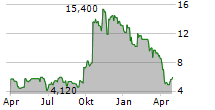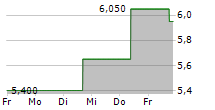
WVE-007 (INHBE GalNAc-siRNA for obesity) is on track to initiate a clinical trial in 1Q 2025; new preclinical data for WVE-007 demonstrate opportunities for monotherapy, for synergistic use with GLP-1s, and for maintenance to avoid rebound weight gain following cessation of GLP-1s
Recent proof-of-mechanism data for WVE-006 unlocked Wave's best-in-class RNA editing capabilities; three new wholly owned RNA editing programs targeting PNPLA3, LDLR and APOB are first-in-class approaches to address significant unmet needs in cardiometabolic diseases
Wave plans to have five GalNAc-RNA editing or GalNAc-siRNA programs in the clinic by 2026
Wave's clinically validated platform continues to lead on the improvement of intracellular delivery using novel chemistry, including PN backbone chemistry modifications
CAMBRIDGE, Mass., Oct. 30, 2024 (GLOBE NEWSWIRE) -- Wave Life Sciences Ltd. (Nasdaq: WVE), a clinical-stage biotechnology company focused on unlocking the broad potential of RNA medicines to transform human health, today announced updates across its growing pipeline, which were also discussed during the company's virtual analyst and investor Research Day (link to webcast). Updates included new preclinical data for Wave's GalNAc-small interfering RNA (siRNA) approach for obesity, WVE-007, which is on track to initiate a clinical trial in the first quarter of 2025. Wave also introduced new, wholly owned GalNAc-RNA editing programs and demonstrated its leadership in oligonucleotide chemistry innovation.
"This year, we showed through multiple positive clinical datasets that our leading RNA medicines platform is opening up new possibilities for the treatment of human disease. Next to the clinic will be our WVE-007 program, which reimagines obesity treatment with a mechanism that directly impacts fat cells - particularly visceral fat - and which could be used as monotherapy, add-on to GLP-1s, or for maintenance post-GLP-1 cessation," said Paul Bolno, MD, MBA, President and Chief Executive Officer at Wave Life Sciences. "Additionally, we are excited to introduce three new programs for mRNA correction and upregulation to treat cardiometabolic diseases with significant unmet needs. These programs have substantial, well-defined patient populations, strong support from human genetics, efficient paths to proof-of-concept in the clinic, and offer the opportunity to meaningfully change health outcomes for millions of people. This truly is an exciting time for Wave and for patients as we unlock new biology and build our high-value and innovative pipeline."
Key Highlights from Today's Virtual Research Day
WVE-007: INHBE GalNAc-siRNA and potential best-in-class obesity therapeutic approaching the clinic
- WVE-007 is Wave's GalNAc-siRNA that targets INHBE as a novel approach to treat obesity. The approach is based on human genetics, where individuals who have a protective loss-of-function mutation in the INHBE gene have a healthier cardiometabolic profile, including less unhealthy visceral fat, lower triglycerides, and lower risk of type 2 diabetes and cardiovascular disease.
- Silencing of INHBE in vivo directly impacts adipocytes (fat cells) and induces lipolysis (fat burning), which is different from GLP-1s' centrally acting mechanism that involves the digestive system and central nervous system to decrease appetite.
- New preclinical data in diet induced obese (DIO) mice demonstrate the potential of WVE-007 to be used across the treatment continuum, including as monotherapy, as an add-on to GLP-1s, and for maintenance to prevent weight regain and weight cycling after discontinuing GLP-1s.
- Wave is on track to initiate a Phase 1 clinical trial for WVE-007 in adults living with overweight or obesity in the first quarter of 2025. The trial is planned to assess safety, tolerability, pharmacokinetics, and Activin E lowering (a biomarker for target engagement), as well as body composition.
New GalNAc-RNA editing programs designed to optimally address high-impact cardiometabolic diseases
- Building on Wave's recent achievement of the first-ever therapeutic RNA editing with WVE-006 in alpha-1 antitrypsin deficiency, the company today announced three new, wholly owned RNA editing programs that are on track for candidate selection in 2025. Like WVE-006, these programs leverage GalNAc conjugation and have efficient clinical paths to proof-of-concept. These new programs include:
- PNPLA3 (mRNA correction): Homozygous PNPLA3-I148M patients are at high risk for a variety of liver diseases and there are more than 9 million impacted individuals in the US and Europe. Wave's RNA editing approach aims to achieve at least 50% correction to restore the heterozygous phenotype with low risk of liver disease, similar to the approach with WVE-006.
- LDLR (mRNA upregulation) and APOB (mRNA correction): High unmet needs remain among familial hypercholesterolemia (FH) patients, with approximately half of patients not reaching goal LDL-c levels with available therapies. Wave's AIMers to upregulate LDLR and correct APOB have potential to be first-in-class treatment approaches for best-in-class effects to reach target LDL-c levels in Heterozygous FH (HeFH) patients. Combined, LDLR and APOB AIMers would address ~1 million HeFH patients in the US and Europe. LDLR upregulation also offers significant expansion opportunities in patients with statin intolerance or prior cardiovascular events (~30 million patients in the US and Europe).
Chemistry innovation enhancing intracellular delivery
- Today, Wave shared data demonstrating how its proprietary chemistry results in marked improvements in five key areas of intracellular delivery: 1) cellular uptake; 2) endosomal release; 3) cellular residency; 4) nuclear uptake; and 5) target engagement.
- Wave shared how it is using PN variants and modifications to physicochemical properties to achieve best-in-class siRNA silencing and RNA editing in a variety of extrahepatic tissues.
- Wave also highlighted novel chemistry used in its AIMers, including proprietary N-3-uridine chemistry (N3U), which substantially enhances RNA editing efficiency. This novel chemistry was the subject of a recent Nucleic Acids Research publication.
An archived webcast of the event can be accessed by visiting "Investor Events" on the investor relations section of the Wave Life Sciences website: https://ir.wavelifesciences.com/events-publications/events.
About Wave Life Sciences
Wave Life Sciences (Nasdaq: WVE) is a biotechnology company focused on unlocking the broad potential of RNA medicines to transform human health. Wave's RNA medicines platform, PRISM®, combines multiple modalities, chemistry innovation and deep insights in human genetics to deliver scientific breakthroughs that treat both rare and prevalent disorders. Its toolkit of RNA-targeting modalities includes editing, splicing, RNA interference and antisense silencing, providing Wave with unmatched capabilities for designing and sustainably delivering candidates that optimally address disease biology. Wave's diversified pipeline includes clinical programs in Duchenne muscular dystrophy, Alpha-1 antitrypsin deficiency and Huntington's disease, as well as a preclinical program in obesity. Driven by the calling to "Reimagine Possible", Wave is leading the charge toward a world in which human potential is no longer hindered by the burden of disease. Wave is headquartered in Cambridge, MA. For more information on Wave's science, pipeline and people, please visit www.wavelifesciences.com and follow Wave on X (formerly Twitter) and LinkedIn.
Forward-Looking Statements
This press release contains forward-looking statements concerning our goals, beliefs, expectations, strategies, objectives and plans, and other statements that are not necessarily based on historical facts, including statements regarding the following, among others: the anticipated initiation, site activation, patient recruitment, patient enrollment, dosing, generation and reporting of data and completion of our clinical trials, including interactions with regulators and any potential registration based on these data, and the timing and announcement of such events; regulatory submissions and timing for regulatory feedback; the protocol, design and endpoints of our clinical trials; the future performance and results of our programs in clinical trials; our expectations with respect to how our clinical data successes to date may predict success for our future therapeutic candidates, future clinical data readouts and further validate of our platform; ongoing and future preclinical activities and programs; the potential of our preclinical data to predict the behavior of our compounds in humans; our identification and expected timing of future product candidates and their therapeutic potential; the anticipated benefits of our therapeutic candidates and pipeline compared to our competitors; patient population estimates related to our therapeutic candidates and the potential addressable market that our therapeutics may address; our ability to design compounds using various modalities and the anticipated benefits of that approach; the breadth and versatility of our PRISM drug discovery and development platform; the expected benefits of our stereopure oligonucleotides compared with stereorandom oligonucleotides; the potential benefits of our RNA editing capability, including our AIMers, compared to others; the benefits of RNA medicines generally; the potential for certain of our programs to be best-in-class or first-in-class; the potential benefits that our "edit-verse" may provide us, including identifying new RNA editing targets; our ability to translate genetic insights into high impact medicines; the status and progress of our programs relative to potential competitors; the progress and potential benefits of our collaborations;;and the anticipated duration of our cash runway and our ability to fund future operations. The words "may," "will," "could," "would," "should," "expect," "plan," "anticipate," "intend," "believe," "estimate," "predict," "project," "potential," "continue," "target" and similar expressions are intended to identify forward-looking statements, although not all forward-looking statements contain these identifying words. Any forward-looking statements in this press release are based on management's current expectations and beliefs and are subject to a number of risks, uncertainties and important factors that may cause actual results to differ materially from those indicated by these forward-looking statements as a result of these risks, uncertainties and important factors, including, without limitation, the risks and uncertainties described in the section entitled "Risk Factors" in Wave's most recent Annual Report on Form 10-K filed with the Securities and Exchange Commission (SEC), as amended, and in other filings Wave makes with the SEC from time to time. Wave undertakes no obligation to update the information contained in this press release to reflect subsequently occurring events or circumstances.
Investor Contact:
Kate Rausch
+1 617-949-4827
krausch@wavelifesci.com
Media Contact:
Alicia Suter
+1 617-949-4817
asuter@wavelifesci.com




